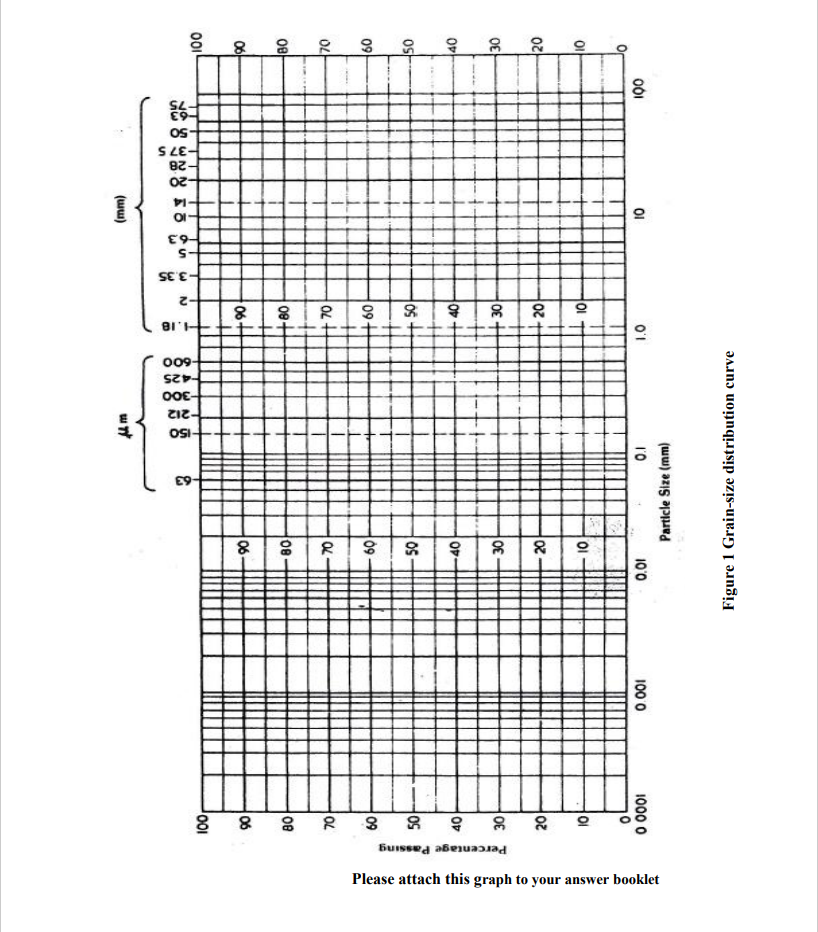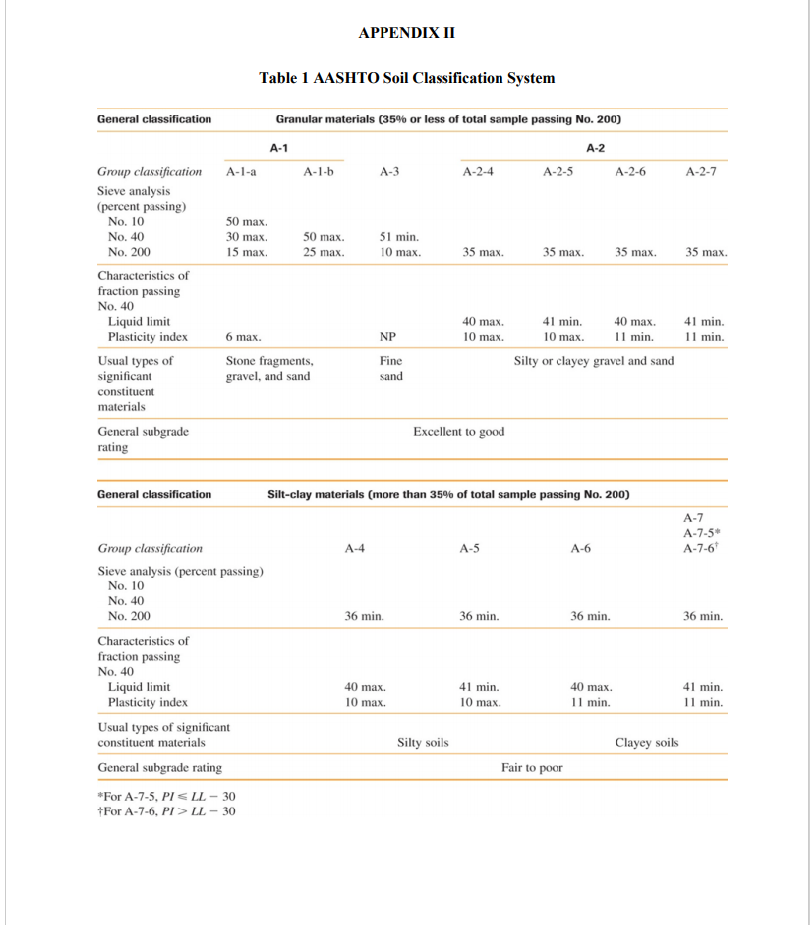Based on this result, plot the particle-size distribution curve and determine the following: i) The percentage passing for each of the sieve size. ii) D10, D30 and D60 from the particle-size distribution curve. iii) The uniformity of coefficient, Cu and the coefficient of gradation, Cc.
Based on this result, plot the particle-size distribution curve and determine the following: i) The percentage passing for each of the sieve size. ii) D10, D30 and D60 from the particle-size distribution curve. iii) The uniformity of coefficient, Cu and the coefficient of gradation, Cc.
Chapter2: Loads On Structures
Section: Chapter Questions
Problem 1P
Related questions
Question
| Opening (mm) |
Mass of soil retained on each sieve (g) |
| 4.75 | 18.0 |
| 2 | 22.0 |
| 0.85 | 40.0 |
| 0.425 | 22.0 |
| 0.25 | 27.0 |
| 0.15 | 30.0 |
| 0.075 | 12.0 |
| 0.02 | 29.0 |
| 0.006 | 21.0 |
| Pan |
30.0 |
Based on this result, plot the particle-size distribution curve and determine the following:
i) The percentage passing for each of the sieve size.
ii) D10, D30 and D60 from the particle-size distribution curve.
iii) The uniformity of coefficient, Cu and the coefficient of gradation, Cc.
iv) Classify the soil using the British Standard Soil Classification System if the liquid limit
and plasticity limit of the soil are 63% and 22%.
Refer Figure 1

Transcribed Image Text:Please attach this graph to your answer booklet
Percentage Passıng
8 8 R 8 8 9 8
E9-
OSI
OOE
425
009-
2
3.35
63
-375
OS
Figure 1 Grain-size distribution curve
Particle Size (mm)
100
OI
100 0
1000 0
OE
os
09
OL
0마
06
06-
01
(wu)

Transcribed Image Text:APPENDIX II
Table 1 AASHTO Soil Classification System
General classification
Granular materials (35% or less of total sample passing No. 200)
A-1
A-2
Group classification
А-1-а
A-1-b
A-3
A-2-4
A-2-5
A-2-6
А-2-7
Sieve analysis
(percent passing)
No. 10
50 max.
No. 40
30 max.
50 max.
51 min.
No. 200
15 max.
25 max.
10 max.
35 max.
35 max.
35 max.
35 max.
Characteristics of
fraction passing
No. 40
Liquid limit
Plasticity index
40 max,
41 min.
40 max.
41 min.
Il min.
11 min.
6 max.
NP
10 max.
10 max.
Usual types of
significant
Stone fragments,
gravel, and sand
Fine
Silty or clayey gravel and sand
sand
constituent
materials
Excellent to good
General subgrade
rating
General classification
Silt-clay materials (more than 35% of total sample passing No. 200)
A-7
A-7-5*
Group classification
A-7-6
A-4
A-5
A-6
Sieve analysis (percent passing)
No. 10
No. 40
No. 200
36 min.
36 min.
36 min.
36 min.
Characteristics of
fraction passing
No. 40
Liquid limit
Plasticity index
40 max.
41 min.
40 max.
41 min.
10 max.
11 min.
11 min.
10 max.
Usual types of significant
constituent materials
Silty soils
Clayey soils
General subgrade rating
Fair to poor
*For A-7-5, PI< LL – 30
tFor A-7-6, PI > LL – 30
Expert Solution
This question has been solved!
Explore an expertly crafted, step-by-step solution for a thorough understanding of key concepts.
Step by step
Solved in 3 steps

Knowledge Booster
Learn more about
Need a deep-dive on the concept behind this application? Look no further. Learn more about this topic, civil-engineering and related others by exploring similar questions and additional content below.Recommended textbooks for you


Structural Analysis (10th Edition)
Civil Engineering
ISBN:
9780134610672
Author:
Russell C. Hibbeler
Publisher:
PEARSON

Principles of Foundation Engineering (MindTap Cou…
Civil Engineering
ISBN:
9781337705028
Author:
Braja M. Das, Nagaratnam Sivakugan
Publisher:
Cengage Learning


Structural Analysis (10th Edition)
Civil Engineering
ISBN:
9780134610672
Author:
Russell C. Hibbeler
Publisher:
PEARSON

Principles of Foundation Engineering (MindTap Cou…
Civil Engineering
ISBN:
9781337705028
Author:
Braja M. Das, Nagaratnam Sivakugan
Publisher:
Cengage Learning

Fundamentals of Structural Analysis
Civil Engineering
ISBN:
9780073398006
Author:
Kenneth M. Leet Emeritus, Chia-Ming Uang, Joel Lanning
Publisher:
McGraw-Hill Education


Traffic and Highway Engineering
Civil Engineering
ISBN:
9781305156241
Author:
Garber, Nicholas J.
Publisher:
Cengage Learning